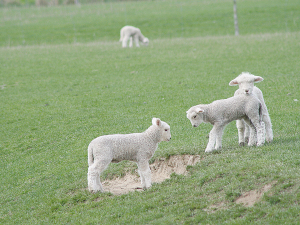How to prevent pneumonia in lambs at weaning
With weaning soon to get underway, some simple management strategies can help prevent the economic losses associated with pneumonia and pleurisy.
 Some simple management ideas can reduce the risk of production limiting diseases like pneumonia and pleurisy in lambs.
Some simple management ideas can reduce the risk of production limiting diseases like pneumonia and pleurisy in lambs.
Weaning, drafting, drenching and shearing create the perfect environment for pneumonia and pleurisy in lambs.
However, some simple management ideas can reduce the risk of these production limiting diseases.
Pneumonia is a disease that causes lesions in the lungs. The most common form is Chronic Non-Progressive Pneumonia which can be caused by bacteria, mycobacteria or viruses.
Symptoms are usually not obvious, although lambs will be slower growing and often pant and cough following exercise.
Lambs with pneumonia are more likely to develop pleurisy, which is where lungs stick to the chest wall. At processing, affected carcasses are downgraded or condemned.
A 2000/2001 study carried out on a database of 1719 farms in Canterbury, Manawatu and Gisborne found the prevalence of pneumonia ranged from 0–100% per flock. But on average, flocks had 24% of lambs affected.
The number of flocks with some pneumonia present ranged from 40–70% – in other words it is very common and costly. Slower growing lambs cost more to feed and then their carcasses are downgraded.
Risk factors include high temperatures and humidity, crowding, stress, dust, excessive exercise, poor ventilation, low immunity and high parasite burdens.
Preventing Pneumonia
Additional reductions to costs for forest owners in the Emissions Trading Scheme Registry (ETS) have been announced by the Government.
Animal welfare is of paramount importance to New Zealand's dairy industry, with consumers increasingly interested in how food is produced, not just the quality of the final product.
Agriculture and Forestry Minister Todd McClay is encouraging farmers and growers to stay up to date with weather warnings and seek support should they need it.
The closure of SH2 Waioweka Gorge could result in significant delays and additional costs for freight customers around the Upper North Island, says Transporting New Zealand.
OPINION: The year has started positively for New Zealand dairy farmers and things are likely to get better.
Ministry for Primary Industries (MPI) Director General Ray Smith believes there is potential for an increase in dairy farming in New Zealand.

OPINION: If the hand-wringing, cravat and bow-tie wearing commentariat of a left-leaning persuasion had any influence on global markets, we'd…
OPINION: With Winston Peters playing politics with the PM's Indian FTA, all eyes will be on Labour who have the…